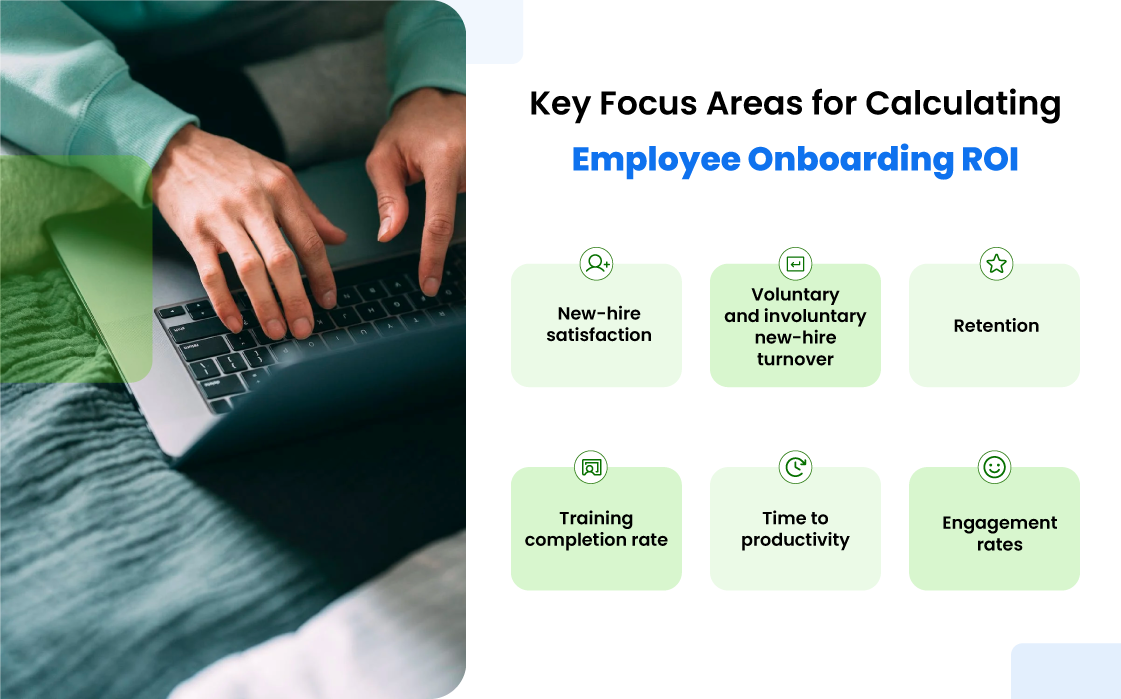In the current corporate landscape, strategic employee onboarding is fundamental to an organization’s growth. It defines how a new employee will perceive your brand as an employer.
A well-mapped-out employee onboarding strategy streamlines every operation by making the process simple for both the candidate and the HR department. It contributes to the employee experience by displaying that the company invests time and resources to make them feel welcome.
Because of the huge shift in workforce dynamics, the traditional approach to employee onboarding is no longer feasible. That’s when the integration of AI and data processing comes into play.
Incorporating emerging technology like artificial intelligence (AI) not only saves the company’s time and resources by eliminating the need for manual redundant operations. It also shows the path to improvement by providing actionable insights.
In this article, we will discuss the role of technology in maximizing employee onboarding ROI and what factors come into play.
What are the key aspects of calculating ROI

For a strategy to work for both the short term and the long haul, quantitative measurements are vital—employee onboarding is no exception. If you identify the right aspects to focus on, even the qualitative measures can be used as quantitative metrics to calculate employee onboarding ROI.
Let us look at some of such vital metrics:
1. New-hire satisfaction
The primary goal of a well-planned employee onboarding process is to make new hires feel welcomed and increase the employee satisfaction rate. This makes ‘new-hire satisfaction rates one of the most crucial metrics to predict the ROI of employee onboarding.
The usual way of measuring new hire satisfaction is by conducting employee interviews and anonymous surveys. After the completion of a successful onboarding process, HRs should proactively reach out to the new hires for feedback on their onboarding experience. Such initiatives also pay off in building employee engagement as employees feel that the leadership is interested in their opinion.
Another method is to apply the net promoter score (NPS). The company can ask the new employees to rate their onboarding experience on a scale from 1 to 10. They can also measure how likely they are to recommend the company to an acquaintance based on their onboarding experience. Those who mark 9 or 10 are promoters, and those who mark 1-6 are detractors. The others in the middle can be considered to be holding a neutral opinion.
| NPS = Percentage of promoters – Percentage of detractors |
2. Voluntary and involuntary new-hire turnover
Voluntary new-hire turnover measures the number of new employees leaving the company on their own. Companies can compare each year’s voluntary new-hire turnover with the previous year. If the rate is higher than the previous year or has not increased much, it indicates something is missing in your employee onboarding and engagement strategy.
On the other hand, involuntary new-hire turnover refers to when a new employee has to be laid off because of sub-par performance. A higher level of this metric indicates that your company’s recruitment process needs optimization.
3. Retention
The measurement of how many new employees decided to stay with your company after the onboarding process says a lot about the employee onboarding ROI of your company. According to SHRM, about 50% of employee attrition occurs within 18 months of joining.
4. Training completion rate
Higher training completion rates indicate a well-structured onboarding. This increases your new employees’ interest in improving their performance. In contrast, poor training completion rates indicate problems like overloading tasks that can lead to burnout.
Proper walkthroughs are the key to proper employee onboarding and, in turn, good employee engagement. It translates to boosted productivity, reduced turnover, and more innovation. It shows that the company is willing to invest in the workforce’s skills development.
That’s why developing plans to make new hires aware of training requirements and upskilling opportunities are one of the best practices to bring increased ROI of employee onboarding. A proper checklist regarding the same also sets a clear picture of holding managers and employees accountable for training completion.
5. Time to productivity
One of the main focuses of structuring an effective onboarding strategy is to equip the new hires with all necessary training and resources so that they can reach maximum productivity as soon as possible. The time it took them to be efficient with their task is another important metric to evaluate employee onboarding ROI.
| Average time to productivity = the Total number of days until a new hire performs at expected levels with little to no oversight in a given period / total number of new hires in the same period |
Note: Time to productivity can vary across teams, job responsibilities, and departments. So, an average range should be applied uniformly within the organization to measure this KPI.
6. Engagement rates
Employee onboarding significantly impacts overall employee engagement. So, calculating your employee engagement rate is an excellent way to gauge the ROI of employee onboarding.
Role of AI in ROI calculation and optimization

Manually handling employee onboarding has a wide array of disadvantages. Besides consuming a lot of time and resources, it also hampers the process of calculating and optimizing the KPIs that determine employee onboarding ROI.
An AI-powered solution can bring robust positive changes to this aspect of employee onboarding. Here are some reasons:
Ability to run processes side by side
Efficient onboarding software is empowered with cutting-edge analytics capabilities. It can seamlessly gather different data sets by processing a wide array of metrics at once.
Intelligent automation enables better transaction accuracy, greater control over the improvements, and standardization across departments. Data collection enables detailed analytics, which can highlight opportunities for process improvement.
Ability to measure impact in real-time
Artificial intelligence processes data and provides immediate reports on HR activities and employee engagement. Features like frequent pulse surveys and task monitoring portray a comprehensive image of a new hire’s motivation, progress, and overall engagement.
With AI-integrated onboarding software, you get real-time visualization of the impact of your onboarding strategies. Such actionable insights and measurements help you to pinpoint the areas that need improvement.
Ability to uncover hidden insights
Besides giving real-time insights, AI-powered analytics are also capable of sentiment analysis. It digs deeper into the responses and data gathered from surveys and generates a report that goes beyond the face value. This helps you personalize the employee onboarding experience, which translates to better employee engagement and increased ROI of employee onboarding.
What are the factors that affect employee onboarding ROI?

Now that we are clear on the different performance indicators of employee onboarding ROI and how artificial intelligence can seamlessly measure them, it is time to look at some factors that impact the ROI of your company.
1. Leadership
Your employee retention rate and management practices go hand-in-hand. The leadership is responsible for setting the right tone for the company’s work culture. According to reports, 100% of the respondents stated that leadership is a key factor in employee happiness and retention.
So it is fair to say that while good leaders can take your ROI to a new level, an incompetent one can also severely harm your company’s growth.
2. Culture
A positive work culture cements your brand as a favorable organization. Similarly, an uncertain work environment can impact your overall ROI in multiple ways. A negative corporate culture is capable of driving your retention rate to the ground.
Elements like negative attitudes, procrastination, extreme workload, and lack of synergy among the workforce plague your organization’s work environment. While rules and regulations are essential to maintain order, overdoing them can create a stifling atmosphere where your employees will live in fear of making simple mistakes.
On the other hand, a good workplace culture facilitates effort and engagement, adding positively to the employee experience. It incentivizes the employee to strive for innovation, makes them feel comfortable enough to come up with new ideas, and encourages them to be willing to go the extra mile. An engaged workforce also raises profits by increasing productivity and retention rate.
3. Work-life balance
The evolved workforce of today wants more than an attractive set of paychecks and benefits; a healthy work-life balance is one of their ultimate priorities. According to the findings of the Corporate Executive Board (which represents 80% of the Fortune 500 companies), employees who enjoy a sustainable work-life balance show 21% more productivity than those who don’t.
When your employees feel they have more control over their work, they will show more engagement. Instead of being all over the place, it allows them to invest their whole focus in one aspect of their lives at a time, ultimately driving up productivity.
Work-life balance programs can pave the way for making more employees feel at ease and reciprocate with dedication. This drives up the employee onboarding ROI to several notches.
4. Ability to adapt to changing employee needs
All the above points will not work unless an organization refuses to change according to the evolved needs of its employees. Adapting to the new norms is a must to be relevant in the current corporate world and to maximize the ROI of employee onboarding.
Inculcating proper technology is an essential aspect of this matter. Without it, employee retention suffers, and productivity reduces. Businesses must change their traditional ways and be more flexible and work-force oriented. That’s the only way to scale up business in the current competitive market.
Conclusion
Evaluating how effective your employee onboarding is, your HR department must frequently look for new ways to optimize the ROI. Doing so needs accurate data processing, metrics tracking, and advanced calculation – none of which is possible by operating manually.
Hence, leveraging technology is the best way to accurate KPI measurements of employee onboarding ROI.
That’s where Leena AI can help you.
Our virtual assistant solution assists HR in delivering a smooth onboarding experience for your new employees. It efficiently handles documentation and processes several sets of data simultaneously, reducing the time invested in onboarding.
Explore how you can increase the ROI of employee onboarding, schedule a demo today.






